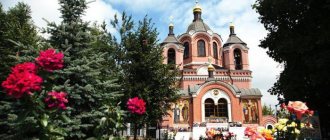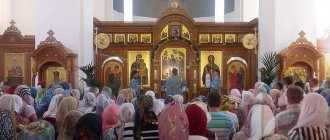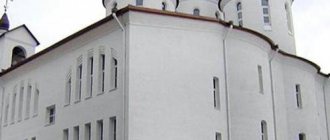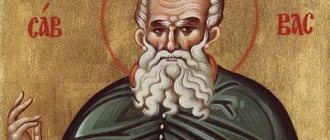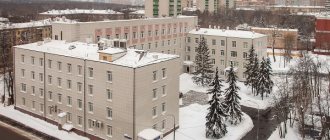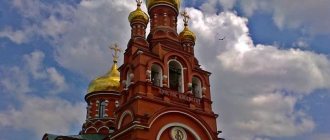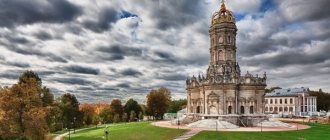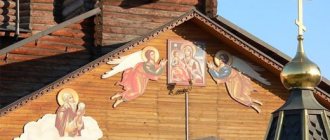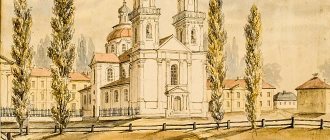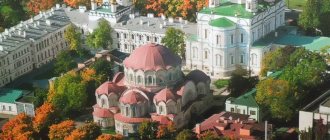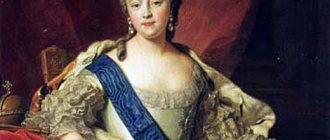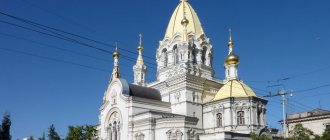| Church of the Icon of the Mother of God “The Sign” in Pereyaslavskaya Sloboda |
Moscow Church in honor of the Icon of the Mother of God “The Sign” in Pereyaslavskaya Sloboda
(Sretensky Deanery of the Moscow Diocese)
- Thrones: icons of the Mother of God “The Sign” (main), Beheading of John the Baptist (right side chapel), St. St. Nicholas the Wonderworker (left side aisle)
- Address: Russia, Moscow, 2nd Krestovsky lane, 17 (metro station Rizhskaya)
- Official site:
- On the map: Yandex.Map, Google map
The Znamensky Church traces its history back to the end of the 16th century, when “of blessed memory, under the Sovereign and Grand Duke Ivan Vasilyevich of All Russia, he built the Pereslavl Yamskaya Settlement on Poklonnaya Hill, and there were fifty coachmen
.
A wooden church built in the settlement was consecrated in honor of the Beheading of John the Baptist (after the namesake of Tsar Ivan the Terrible). Soon a chapel appeared in the temple in honor of St. Nicholas, whom the coachmen especially revered as the patron saint of travelers. And already in 1638, in the Census Book of the City of Moscow it was written: “In Pereslavskaya, in Gonnaya Sloboda, in the name of the Church of the Sign of the Most Pure Mother of God
. History has not preserved the reason for the renaming.
| Moscow Church in honor of the Icon of the Mother of God “The Sign” in Pereyaslavskaya Sloboda, 1882. Photo from Naydenov's album |
In 1757, “through the diligence of parishioners and outside willing donors,”
construction began on a stone church, which was consecrated in 1765 and exists to this day. Built in the Baroque style, the building has a symmetrical axial composition.
In 1888, the temple was rebuilt, increasing its interior. At the same time, the side aisles were extended in a row with the main one, and the bell tower was built up on the sides. Consistent and accurate reproduction in the architecture of the later aisles and extensions of the original Baroque forms allows us to perceive the building as stylistically unified. The red color of the walls and the white color of the details give the temple a strict and at the same time elegant look.
The carved gilded iconostasis, made at the end of the 19th century, reflects the development of the Russian style in church decoration. Five-tiered in the center and two-tiered in the side aisles, it is designed in the traditions of the 16th-17th centuries. The painting of the temple was done in 1899 by the artist Ya. E. Epanichkov. At the beginning of the century, an almshouse and a parochial school operated at the temple.
During Soviet times, the church was not closed; the bells were even preserved on its bell tower. The temple received shrines from the closed and destroyed surrounding churches.
History of the appearance of the temple
In the 16th century, in the Pereyaslavskaya Sloboda there was a small wooden church, named in honor of the Beheading of John the Baptist . But the fire completely destroyed the church. A year later, in 1713, a new church, called “The Signs of the Most Pure Mother of God,” already stood in its place.
44 years passed and, with donations from Orthodox citizens, the construction of a stone church building began. In 1765, the Church of the Sign of the Most Pure Mother of God was consecrated. At the end of the 19th century, the temple underwent reconstruction - new boundaries and a passage between the bell tower and choir were added to it. It still stands in this form.
The temple was originally built in the Baroque style; later reconstructions were carried out in the same style and therefore the impression of a single completed structure is created. In the Temple of the Sign there are 4 thrones, each of which has its own revered image:
- the central altar is the Most Pure Mother of God “The Sign”;
- southern throne - “Beheading of John the Baptist”;
- northern throne - St. Nicholas;
- side altar – St. Martyr Tryphon.
The last of the thrones was presented to the temple as a gift by the skilled woodworker V.I. Kudinov (1980). The throne was made of giant oak, which was 250 years old.
The outside walls of the temple building are painted red and finished with white paint. The combination of these colors gives the temple a solemn and festive look. The interior decoration of the Church of the Sign amazes with its highly artistic taste.
The interiors are decorated in warm pastel colors; there is nothing bright or flashy. Everything is in moderation, it is felt that the design work was carried out with great love.
Znamensky Temple in Tula
Rector – Archpriest Pavel Ignatchik
History of the temple
At the intersection of Arsenalnaya and Stvolnaya streets there is the Holy Sign Church, erected in honor of the Icon of the Mother of God “The Sign”. In this icon, the Mother of God is represented with her hands raised in prayer and the Divine Child appearing in her bosom. Prototypes of this image were available in Rome in the 4th century. This icon became famous in the 12th century in Novgorod, when the Vladimir-Suzdal prince Andrei Bogolyubsky, in alliance with other princes, planned to conquer Novgorod.
In the winter of 1170, a huge army besieged Novgorod, demanding surrender. The “Sign” icon, located in the Church of the Savior on Ilyinskaya Street, was brought to the city wall and placed facing the attackers. But they shot a cloud of arrows at her. One of them wounded the sacred face, and tears flowed from the eyes of the Mother of God. And immediately horror fell on the attackers, their vision darkened, and they began to strike each other. The Novgorodians opened the gates, rushed at the enemies and completely defeated them.
The history of the creation of the Holy Sign Church was not an easy one. This is one of four churches built on the outskirts of Tula by decision of Bishop Pitirim of Tula and Belevsky (details about that decision are in the chapter on the Temple of the Twelve Apostles). Most of the churches were concentrated in the center of Tula and could not satisfy the religious needs of the population of the outskirts.
Particularly sad in this regard was the situation of the inhabitants of the trans-river part of the city and Chulkovaya Sloboda, some quarters of which, with unpaved streets and impassable mud in the autumn and spring months, were “versts away” from local churches. And despite these obstacles, not everyone could fit into the crowded churches.
At the beginning of 1898, the priest of the Holy Spirit Church (George on Khopra), in fulfillment of an order received from the archbishop's office, provided information about the possibility of building a temple on the outskirts of the parish. Three options for its placement were considered. True, the owners of the two plots asked for a rather high price for them, which did not suit the diocese.
And the tradesman Alexander Nikolaevich Avchinnikov (the spelling of his last name is Ovchinnikov) agreed to donate his plot, located on Dulnaya Street, as well as bricks for the construction of the temple. Avchinnikov also gave up his wooden house, which stood on the site, as a temporary church.
On June 3, 1898, the temporary temple was consecrated. Literally a few days before the consecration, the premises of the future temple were equipped with icons, many brought by surrounding residents, an iconostasis and an improvised belfry with bells were built. The area around the temple was fenced off and cleared. Residents also put in order the surrounding streets leading to the temple from the Holy Spiritual Church, from which a religious procession was supposed to take place on the day of consecration.
In the fall, they began laying the foundation and walls of a stone church around the wooden temple. But the following spring, construction had to be stopped due to the extreme weakness of the soil.
Then a member of the temple construction committee, merchant Mikhail Petrovich Vladimirov, donated two adjacent plots for the construction of the church, located at the intersection of Stvolnaya and Arsenalnaya streets, volunteered to transport building materials at his own expense to a new location and provide some more bricks.
First, a temporary wooden church-school was built on the new site, consecrated in September 1899, built at the expense of the same M.P. Vladimirova. Already since 1898, there were two parish schools in the parish - for boys and for girls.
For the construction of a stone temple, three thousand rubles were bequeathed by a famous benefactor, merchant D.Ya. Vanykin.
The construction of the stone Church of the Holy Sign was completed in 1905. There were three altars in the temple: the main one - in the name of the icon of the Mother of God, called “The Sign”, the right one - in the name of the Archangel Michael, the left one - in the name of the Venerable Seraphim of Sarov. The iconostasis of the main altar was made of white marble.
Forged openwork grilles on the windows of the temple have been preserved to this day.
A wooden temporary bell tower was erected on pillars. They did not have time to erect a stone belfry.
On September 7, 1914, the wall painting of the Znamensky Church was completed.
The volumetric space of the church was decided according to the traditional design for the 18th - 19th centuries. scheme: elongated refectory and main volume, altar apse. But the decor of the temple is in the Russian style: a combination of red brick with white stone, the use of the entire arsenal of ancient Russian decorative elements - semicircular and pointed kokoshniks above the windows, columns framing the window openings, flies on the pilasters and under the windows. That is, the Holy Sign Church is a wonderful example of eclecticism, which combines the volumetric space solution characteristic of classicism and decor in the spirit of ancient Russian churches.
The temple ended with an elegant five-domed structure, which deserves a separate comment.
It rested on two rows of keel-shaped kokoshniks. It was this type of finishing of churches that architects in Moscow used in the second half of the 17th century. As examples, we can name the Moscow churches of St. Nicholas in Pyzhi (1672) and St. George in Endov (1654), which have survived to this day. True, in them the kokoshniks at the base of the five domes are larger, their number is smaller, and the domes themselves are placed more widely apart from each other than in the Church of the Holy Sign. The shapes and proportions of the five-domed church in our Tula church are closest to the five-domed church in the name of the Kazan Icon of the Mother of God in Kolomenskoye (Moscow, 1653), but in the Kazan church there are no kokoshniks at the base of the five-domed church.
At the end of the 19th - beginning of the 20th centuries. Russian architects often turned to ancient Russian models when building churches. The five-domed church of the Holy Sign had predecessors. This is exactly how the church in the name of the icon of the Mother of God “Joy of All Who Sorrow” was completed at the Imperial Glass Factory near St. Petersburg (1894, architects A. Gauguin, A. Ivanov) with five onion-shaped domes on a base decorated with two rows of kokoshniks.
In 1924, the Tula authorities attempted to take the temple away from the community of adherents of Patriarch Tikhon, refusing to renew the agreement for the use of the Holy Sign Church. However, parishioners filed a complaint with the All-Russian Central Executive Committee. They also informed this supreme authority that the Tula authorities intended to transfer all the city’s churches into the hands of the renovationists. The Tulgubi Executive Committee received a letter dated April 25, 1924, signed by the Chairman of the All-Russian Central Executive Committee M.I. Kalinin, in which the Tula authorities were proposed to “resolve the issue of using the Orthodox churches available in Tula by distributing them between Orthodox believers of the old and new persuasions, if possible, in accordance with the number of believers of one or another persuasion.” The Gubernia Executive Committee had to listen to the opinion of their superior comrades, especially since the Tikhonov community in this case was probably much more numerous than the Renovationist applicants. The agreement on the transfer of the temple for the use of the “old church” group of believers was signed on July 22, 1924. The temple operated for another 15 years.
The Church of the Holy Sign was closed on the basis of a resolution of the organizing committee of the Presidium of the Supreme Council of the RSFSR for the Tula region dated June 22, 1939. The white marble iconostasis (or part of it) was moved to the Savior Cemetery Church, where it is still located. The church building was transferred to the Zarechensky district council for conversion into a military training center and a station for the Osoaviakhim air and chemical maintenance facility.
Interesting are the memories of local old-timers who said that in the fall and winter of 1941-42, during the days of the defense of Tula, residents of nearby houses hid in the former temple during bombing, and no one doubted that its walls would reliably protect against enemy bombs. And so it happened: the temple was not damaged then.
After the war and until the end of the 20th century, the building of the Holy Sign Church housed warehouses of Tulshakhtostroy and other organizations, workshops of the repair and construction department.
The five-domed church was demolished in 1956. The photograph shown in this book was provided by the rector of the temple, priest Pavel Ignatchik. He said that parishioners brought this photograph to the temple. The photo was taken in the 1950s shortly before the demolition of the five-domed building.
In 1991, the temple building was placed under state protection as a historical and cultural monument of regional significance.
In December 2001, the temple was returned to the Tula diocese. According to the rector of the temple, during renovation work in the church, a burial was discovered under the floor of the southern aisle near the altar - a crypt, which, of course, was not opened. Perhaps, suggests priest Pavel Ignatchik, M.P. was buried here. Vladimirov, who died in 1904.
Currently, the temple is being restored through the efforts of the parish. The parish has two priests and a deacon. The church has a Sunday school and a church singing group. In the kindergarten at education center No. 12, weekly classes are held on the basics of Orthodox culture. Cooperation with nearby educational institutions is developing.
Address: Tula, st. Arsenalskaya, 5-a
Telephone:
Email:
Divine services are held daily.
On weekdays, Sundays and holidays :
Divine Liturgy – 9:00
Evening service - 17:00
Accessible environment for people with limited mobility:
If you need help entering the temple, climbing the stairs, moving around the temple and the temple grounds, then you can first leave a request to the assistant rector for social service and charity, Priest Alexy Myasnov, by phone: 8-920-758-15-57.
Call time: Mon-Sun from 8.00 to 17.00 .
You can also leave a request for a clergyman to visit you at home to perform the Sacraments of Confession, Communion, and Unction.
Shrines of the Temple of the Sign
During Soviet atheism, many churches in Moscow were closed and destroyed. The Znamensky Church was active at that time, and shrines from damaged churches were brought there. Nowadays, under the temple vaults of the Sign, the capital's volumes of the Christian faith are collected.
Icon with the relics of Saint Tryphon
Icon of the Mother of God in the Znmensky Church
Particularly revered temple icons and symbols of Orthodoxy:
- The image “The Sign ” is the main temple face , copied from a 16th century icon (Novgorod). The Mother of God is depicted with her hands raised in prayer, with the Divine Child depicted on her chest.
- The image of John the Baptist is a 17th century icon; in 2000, it was miraculously renewed in front of the parishioners.
- Image of St. much Tryphon - icon from the Church of St. Tryphon (1931). The image depicts particles of the relics of St. much Tryphon.
- The image of the wonderworker Seraphim of Sarov - the icon was handed over by the sisters of the Diveyevo metochion after its closure in 1927. Along with the icon in the temple there are also parts of the coffin of St. Seraphim.
- The Honest and Life-Giving Cross of the Lord - a crucifix from the Passionate Monastery ( 30s of the 20th century).
- The miraculous Krestovsky Cross - the shrine dates back to 1652, appeared in the temple in 1929. Initially, the Cross stood in the chapel at the Krestovskaya outpost. The chapel was destroyed.
Locally revered shrines
The Church of the Sign of the Mother of God is equipped with a carved wooden gilded iconostasis, which has five tiers in the central chapel and two tiers on the sides. The temple iconostasis represents a collection of holy images of the “Moscow” letter.
Round medallions decorate the icons of the Prophetic tier, as well as the Festive tier. The top is crowned with carved images of angels. The forefathers' row contains small-sized images wearing three-bladed kokoshniks.
This is interesting! Day of the Assumption of the Blessed Virgin Mary: what is the history of the holiday
The Icon of the Most Holy Theotokos “The Sign” depicts the Virgin Mary with her hands raised in prayer as a sign of mercy to the believers, as well as the Baby Jesus appearing in her bosom.
This image is a copy of an ancient icon from the 16th century. It is located next to one of the most revered icons of the Mother of God by Orthodox Christians.
What do believers pray for before this image:
- protection from fires and other natural disasters;
- reconciliation of warring parties;
- protection from thieves;
- for eye diseases;
- getting rid of envious people.
In the Moscow Church of the Icon of the Mother of God “The Sign”, the miraculous image of the martyr Tryphon (photo 3), brought to Rizhskaya from the closed Trifonovsky Church (the date of its closure - 1931), also enjoys special respect among parishioners. This miraculous image contains silver reliquaries with the relics of the holy martyr Tryphon.
In the name of this miracle worker, an additional throne was even consecrated in 1980. Nowadays, some parishioners simply call the temple on Rizhskaya with the icon of the martyr Tryphon Trifonovsky.
Important! In Rus', this saint has been revered for many centuries. Believers resort to the prayerful help of the martyr Tryphon for a wide variety of troubles and needs.
They ask Tryphon for many things:
- successful employment;
- acquiring new housing;
- prosperous marriage, as well as family life;
- protection from witchcraft and all other evils;
- help in everyday troubles.
Every day after the end of mass, a prayer service with blessing of water is served in front of the Tryphon icon. On Wednesdays, after the evening service, an akathist to the saint is sung. Every year on February 14, solemn services are held here, performed by the bishop's rank.
There are many images of the Most Pure Virgin Mary in the temple:
- Ozeryanskaya,
- Bogolyubskaya,
- Cover,
- Kazanskaya,
- Vladimirskaya,
- "The Unbreakable Wall"
- Korsunskaya,
- "Blessed Sky"
Here you can pray at the crucifix and holy images: the Trinity, Jesus Christ, martyrs, prophets, apostles.
This is interesting! History of the All-Tsaritsa icon.
In addition, there are many images of Russian saints:
- St. Demetrius of Rostov;
- Rev. Sergius of Radonezh;
- Rev. Seraphim of Sarov with a piece of his coffin;
- svmch Hermogenes;
- Equal to the Apostles Princess Olga;
- MCC Apollinaria Tupitsyna.
How to get to the temple
The Temple of the Sign on Rizhskaya is located at the address: 2nd Krestovsky lane, 17, p. 1.
You can get to it using the metro - the nearest station is Rizhskaya, you only have to walk for a couple of minutes. You can get there by bus, routes 239, 84, T25, stops are located near the temple. Nearby, within a few minutes' walk, is the Rzhevskaya railway platform, where electric trains from Belarus, Kursk and Riga stop. This type of transport, if convenient, can also be used.
Schedule of services
Liturgy in the Znamensky Church is served daily. On weekdays once, at 8 o'clock in the morning. On Sundays and holidays the service is held twice, at 7 o'clock and 10 o'clock in the morning. The evening service begins at 17:00 in winter, and at 18:00 in summer.
Every day at the end of the liturgy a prayer service is served with an akathist to St. much Tryphon. After the Sunday evening service there is a prayer service with the blessing of water and the reading of the akathist the Sign of the Most Pure Theotokos. You can also order a memorial service for the deceased. It is held after the liturgy.
